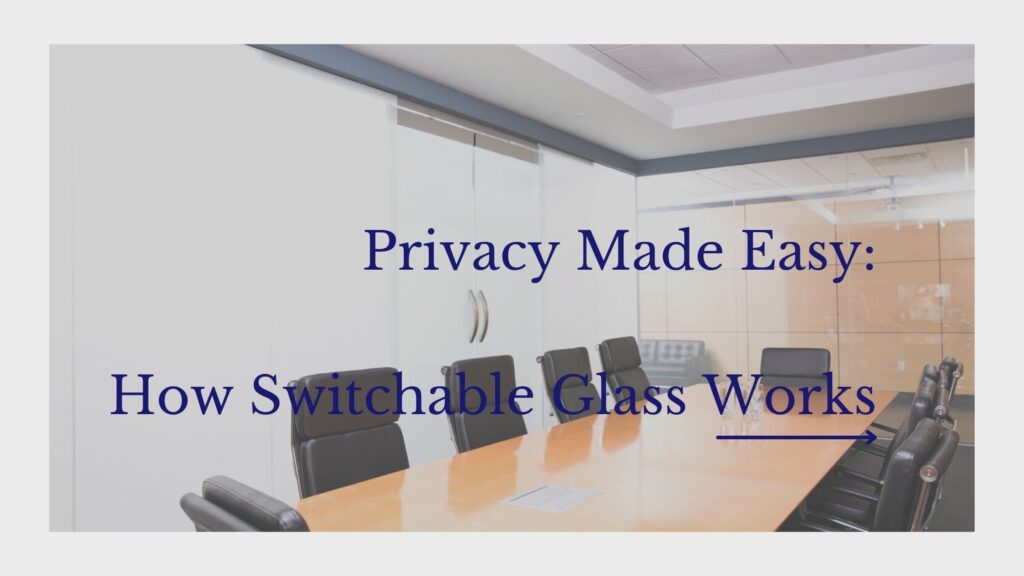What is Switchable Glass?
Switchable glass, also known as smart glass or privacy glass, introduces an innovative technology that enables instant privacy control with a simple switch. This glass finds applications in windows, doors, skylights, and partitions, offering a versatile solution to privacy needs.
Switchable glass presents an array of advantages and diverse applications, making it a preferred choice for both residential and commercial settings. In homes, it facilitates creating private areas within open layouts, elevates bathroom privacy, and transforms a home office into an isolated workspace. In commercial environments, it serves in conference rooms, office dividers, and storefronts, ensuring privacy as needed and fostering adaptable spaces.
How Does Switchable Glass Work?
The functionality of switchable glass relies on polymer-dispersed liquid crystal (PDLC) technology. By applying an electrical current, the embedded liquid crystal molecules respond, altering their orientation. This orientation allows the light to pass through, causing the glass to appear clear. Upon turning off the current, the molecules then relax to a scattered state, which disrupts the path of light, making the glass appear opaque.

Benefits of Switchable Glass
Switchable glass offers a range of benefits that make it a popular choice in various settings:
- Privacy: One of the primary advantages of switchable glass is its ability to provide instant privacy control. Whether in an office meeting or at home, switchable glass allows users to create a private space whenever needed.
- Energy Efficiency: Switchable glass can also contribute to improved energy efficiency. When in an opaque state, it can block out sunlight and reduce the need for cooling. In transparent mode, it allows natural light to pass through, reducing the reliance on artificial lighting and saving energy.
- Design Flexibility: With switchable glass, there is no need for curtains or blinds, allowing for a clean and modern aesthetic. It offers design flexibility, making it suitable for various architectural styles and interior designs.
- Security: Switchable glass can enhance security by providing a barrier between different areas. In commercial settings, it can prevent unauthorized access to restricted areas, while in residential homes, it can act as an additional layer of security.
Installation and Maintenance
The installation process for switchable glass is similar to that of regular glass. It can be installed in windows, doors, partitions, and other areas where privacy control is desired. However, it is essential to hire professionals with experience in installing switchable glass to ensure proper functioning and longevity.
Maintenance of switchable glass is relatively simple. Regular cleaning with a mild (non-acidic) glass cleaner and a soft cloth is usually sufficient to keep the glass in optimal condition. It is important to avoid using abrasive materials or harsh chemicals that may damage the glass or its electrical components.
Popular Uses of Switchable Glass
Switchable glass has seen widespread adoption in various industries and settings:
- Residential: In residential homes, switchable glass can be used for bathroom windows, bedroom partitions, or even as a unique feature in a kitchen backsplash.
- Commercial: Office buildings often utilize switchable glass in conference rooms, office partitions, and reception areas, providing privacy for meetings or individual workspaces.
- Healthcare: Switchable glass is commonly used in healthcare settings, such as hospitals and clinics, to create private spaces for patients, examination rooms, and waiting areas.
- Automotive: Luxury vehicles often incorporate switchable glass for privacy in the back seats or to create a separation between the driver and passengers.
Conclusion
In conclusion, switchable glass employing PDLC technology offers a convenient and adaptable solution for privacy control. Its ability to transition from transparent to opaque effortlessly revolutionizes privacy across residential, commercial, and automotive settings. With numerous benefits like increased security, energy efficiency, and design flexibility, switchable glass remains an enticing choice for those seeking privacy without compromising aesthetics.